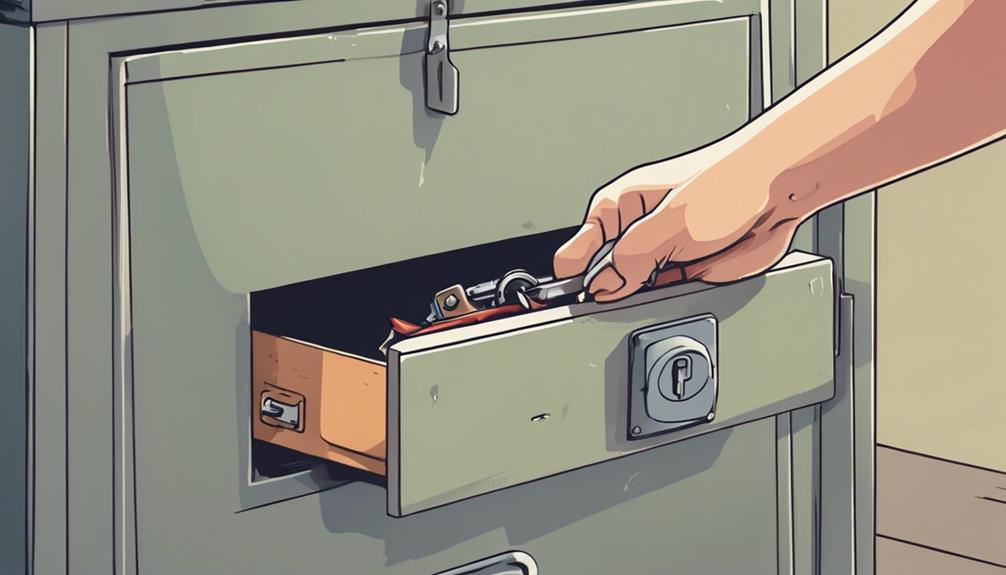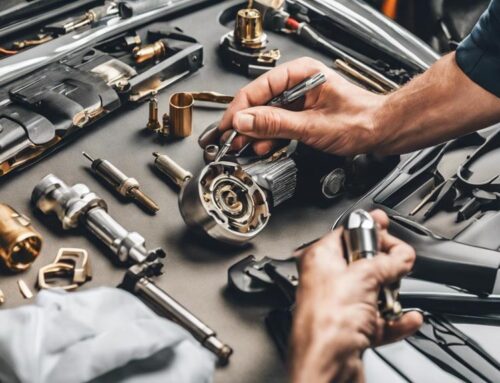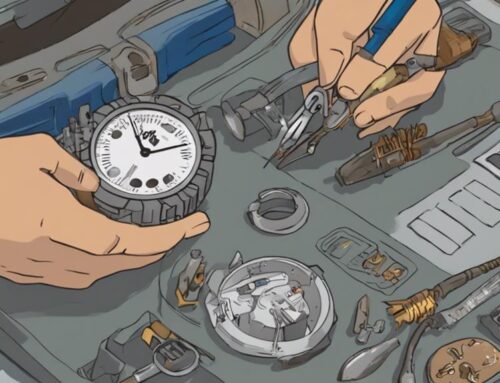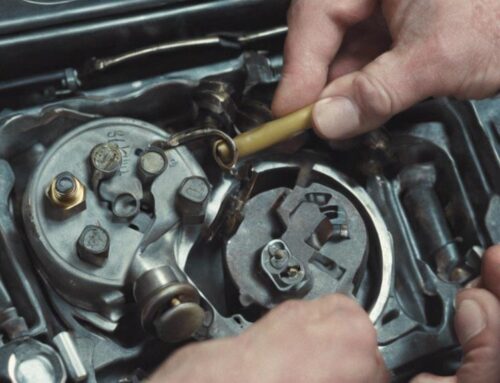You might not realize that the materials used in your desk or file cabinet locks can greatly affect their longevity and performance. When a lock jams, it's essential to know the right steps to take to avoid further damage and potential security issues. Understanding common causes and effective maintenance strategies can save you time and frustration. What if you could prevent these annoyances before they even start?
Key Takeaways
- Assess the lock for debris or foreign objects that may be obstructing the mechanism before attempting to unlock it.
- Gently jiggle the key while applying light pressure to engage the lock mechanism without forcing it.
- Regularly lubricate locks with high-quality lubricant every six months to enhance performance and prevent jams.
- Conduct visual inspections and clean locks periodically to remove dust and debris that can cause operational issues.
- Monitor the weight limit and organization of files in cabinets to avoid overloading and prevent lock jams.
Common Causes of Jammed Locks

When dealing with jammed locks, it's important to pinpoint the common culprits behind the issue. Various lock types, such as pin tumbler or disc detainer locks, may experience malfunctions due to debris accumulation or wear. Dust and dirt can obstruct the critical components, causing jammed keys that refuse to turn. Additionally, humidity and temperature fluctuations can lead to swelling in wooden cabinets, further complicating the lock's functionality. Improper key usage, like forcing the key, can also contribute to bending or breaking, rendering the lock useless. Regular maintenance and understanding these causes empower you to prevent future lock jams, ensuring your cabinets and desks remain secure and accessible. If you're interested in learning about signs that your commercial locks need attention and care, check out Signs Your Commercial Locks Need Attention and Care for more information.
Immediate Steps to Take
Immediate action can considerably mitigate the frustration of dealing with a jammed lock. First, assess the situation to verify there are no foreign objects obstructing the lock mechanism. If you identify debris, carefully remove it. Next, try gently jiggling the key while applying light pressure to see if you can engage the mechanism. If that doesn't work, you might need to lubricate the lock with graphite powder, a preventive measure that can help avoid future jams. For emergency fixes, if the lock remains stuck, consider using a hairdryer to warm the lock slightly, which can expand the metal and ease the jam. Always prioritize these steps to maintain your locks effectively and minimize disruptions.
Tools You Might Need
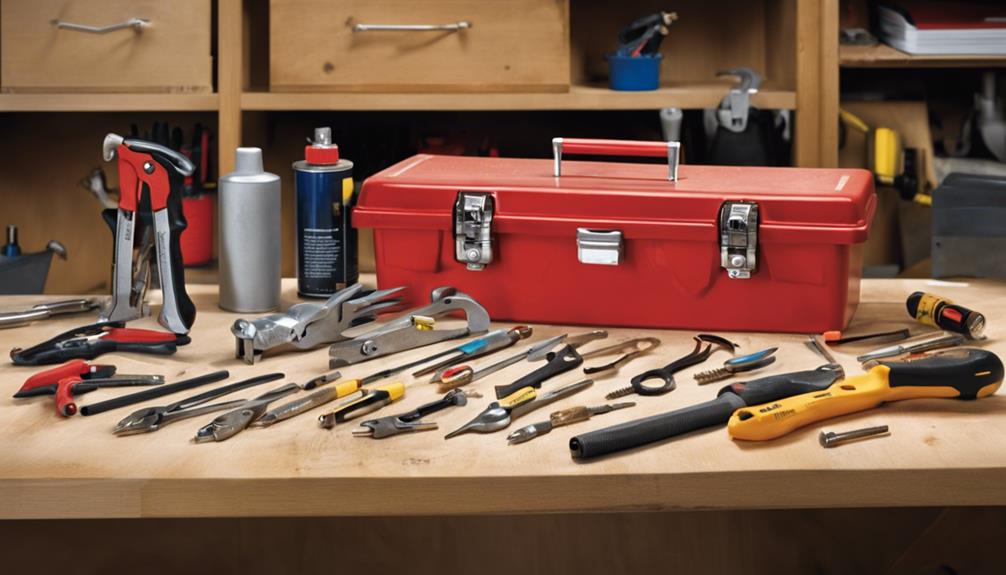
To effectively maintain and troubleshoot file cabinet and desk locks, you'll need a few essential tools at your disposal. Having the right locksmith tools can make all the difference in ensuring your locks operate smoothly. Here's a quick reference table of tools you might consider:
| Tool | Purpose |
|---|---|
| Screwdriver | Remove screws from locks |
| Lubricant spray | Reduce friction in locks |
| Lock pick set | Open locked mechanisms |
| Pliers | Manipulate components |
| Flashlight | Illuminate dark areas |
Additionally, keep some emergency supplies handy, like a backup key or lock bypass tool. These tools empower you to maintain control over your locks, ensuring your documents remain safe and accessible.
Safe Lock Picking Techniques
Safe lock picking techniques require a careful approach and a solid understanding of lock mechanics. To begin, you'll need a tension wrench and appropriate pick tools. Insert the tension wrench into the lower part of the keyway, applying gentle pressure in the direction the lock turns. This tension stabilizes the pins inside the lock. Using your pick tools, feel for the pins and lift them one by one until you hear a subtle click. Maintain consistent pressure with the tension wrench while manipulating the pins. Once all the pins are set, turn the tension wrench to release the cabinet or desk. Mastering these techniques not only enhances your skills but also empowers you to tackle lock-related challenges with confidence.
Lubrication and Maintenance Tips
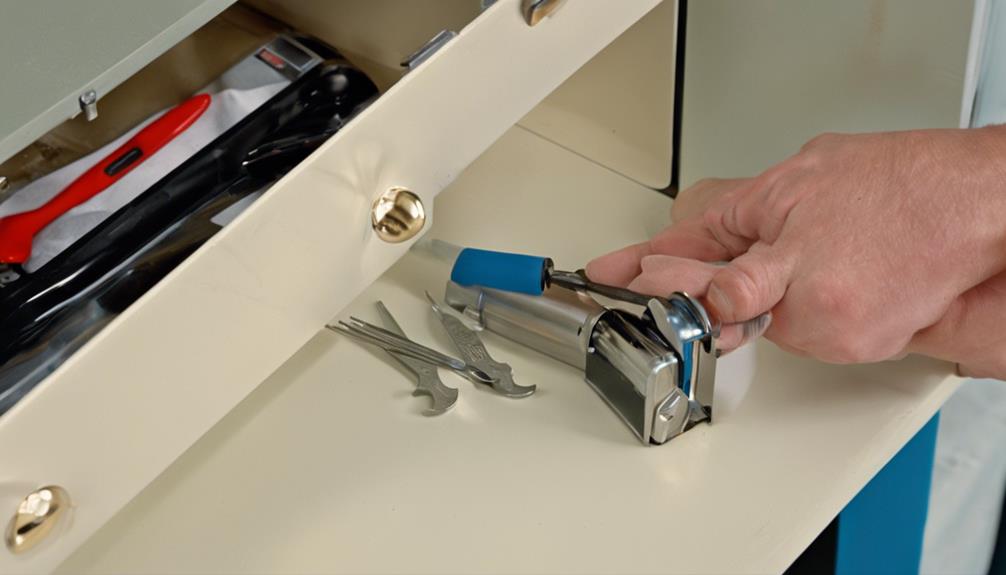
To guarantee your file cabinet and desk locks operate smoothly, establish a regular lubrication schedule. Clean the lock mechanisms periodically to remove dust and debris that could hinder performance. This proactive maintenance will enhance longevity and reliability, preventing unexpected lock failures.
Regular Lubrication Schedule
Establishing a regular lubrication schedule is crucial for maintaining the functionality and longevity of file cabinet and desk locks. Depending on the lock types you utilize, you should aim for a maintenance frequency of at least once every six months. For high-usage locks, consider increasing this frequency to every three months. Use a high-quality lubricant designed specifically for locks to guarantee peak performance. Apply lubricant directly into the keyhole and the moving parts, allowing it to penetrate deeply. After lubrication, operate the lock several times to distribute the lubricant evenly. By adhering to this schedule, you'll not only prevent jamming but also enhance the overall security and efficiency of your locking mechanisms, empowering you to protect your valuable assets effectively.
Cleaning Lock Mechanisms
Regularly cleaning lock mechanisms is vital for guaranteeing smooth operation and preventing corrosion. Start by using a can of compressed air to blow out dust and debris from the lock. This prevents buildup that can impede performance. Implementing a lock maintenance program, as explained in the Essential Lock Maintenance for Business Security article, is important for maintaining the security of your business. Next, apply a high-quality lock cleaner to dissolve any grime or residue. After that, lubricate the lock with a silicone-based lubricant to promote fluid movement. Avoid using oil-based products, as they can attract dirt and cause gumming. Regular lock maintenance not only enhances functionality but also extends the lifespan of your locks. Make it a habit to clean your locks every few months, especially in high-use areas, to maintain their reliability and security. Prioritize these steps to assert control over your lock mechanisms.
Regular Inspection Practices
Regular inspection practices are vital to guarantee your file cabinet and desk locks function properly. To enhance security, it is imperative to conduct a visual lock assessment to identify any signs of wear or damage. Additionally, regular security audits can help identify vulnerabilities and recommend tailored security enhancements. Establish a lubrication schedule and remove dust and debris regularly to maintain peak performance.
Visual Lock Assessment
Consistently conducting a visual lock evaluation is vital for guaranteeing the security of your file cabinets and desk locks. Begin by identifying the lock types present in your workspace. Examine each lock for signs of wear, corrosion, or damage that could compromise its integrity. Check the alignment of the locking mechanism to confirm it engages correctly. Evaluate key compatibility by testing each key in its corresponding lock; a tight fit indicates proper functionality. Look for any unusual movement or resistance when operating the locks. By regularly evaluating these elements, you can proactively address potential issues, securing your important documents and assets effectively. Stay vigilant in this practice to maintain ideal security and functionality. Remember, keeping your locks in top condition is essential for preventing security breaches and maintaining the confidentiality of your business information.
Lubrication Schedule
A well-planned lubrication schedule is essential for ensuring the longevity and smooth operation of your file cabinet and desk locks. Different lock types require specific maintenance frequency to optimize performance. Here's a suggested lubrication schedule:
- Monthly: For high-use locks, apply a dry lubricant to prevent dust accumulation. Regular cleaning Essential Maintenance Tips to Prevent Lockouts and Repairs is vital for the overall health of your locks.
- Quarterly: Inspect and lubricate medium-use locks to maintain functionality.
- Biannually: Conduct thorough maintenance for low-use locks, ensuring they're in good working order.
- Annually: Review all locks, replacing any that show signs of wear or damage.
Dust and Debris Removal
To keep your file cabinet and desk locks functioning properly, dust and debris removal is essential. Regularly inspect the lock mechanisms, making sure to clear any accumulated dirt or particles. Use a soft brush or compressed air to perform effective lock cleaning, targeting crevices where debris tends to gather. This proactive approach not only enhances the lock's performance but also aids in debris prevention, ultimately extending the lifespan of your locks. Additionally, take a moment to check the surrounding areas for clutter that could obstruct the lock's operation. By incorporating these maintenance practices into your routine, you empower yourself to prevent future issues and maintain peak function. Prioritize cleanliness to safeguard your valuable assets and guarantee smooth access.
How to Avoid Overloading

When managing file cabinets and desk locks, it's vital to avoid overloading them to guarantee peak performance and longevity. Proper file organization and strategic weight distribution are key to preventing jams and guaranteeing smooth operation. Here are four significant steps you can take:
- Assess Capacity: Know the weight limits of your cabinets and desks, and consider high-security and fireproof options for added protection.
- Distribute Weight Evenly: Place heavier items on lower shelves to maintain stability.
- Limit File Volume: Don't pack drawers to their brim; leave space for expansion.
- Regularly Review Contents: Periodically declutter to guarantee ideal weight distribution and organization.
Signs of Lock Wear and Tear
Recognizing the signs of lock wear and tear is essential for maintaining the security of your file cabinets and desks. Pay attention to any difficulty when inserting or turning the key, as this indicates internal damage. Listen for unusual sounds, like grinding or clicking, which suggest that lock durability factors are compromised. If the lock feels loose or wobbly, it may be nearing failure. Additionally, monitor the frequency of routine usage impact; excessive use can accelerate wear. Corrosion or rust around the keyhole is another red flag, signaling potential lock deterioration. Regularly evaluating these signs can help you address issues before they escalate, ensuring your locks remain reliable and effective in securing your valuable assets.
Professional Help From Low Rate Locksmith
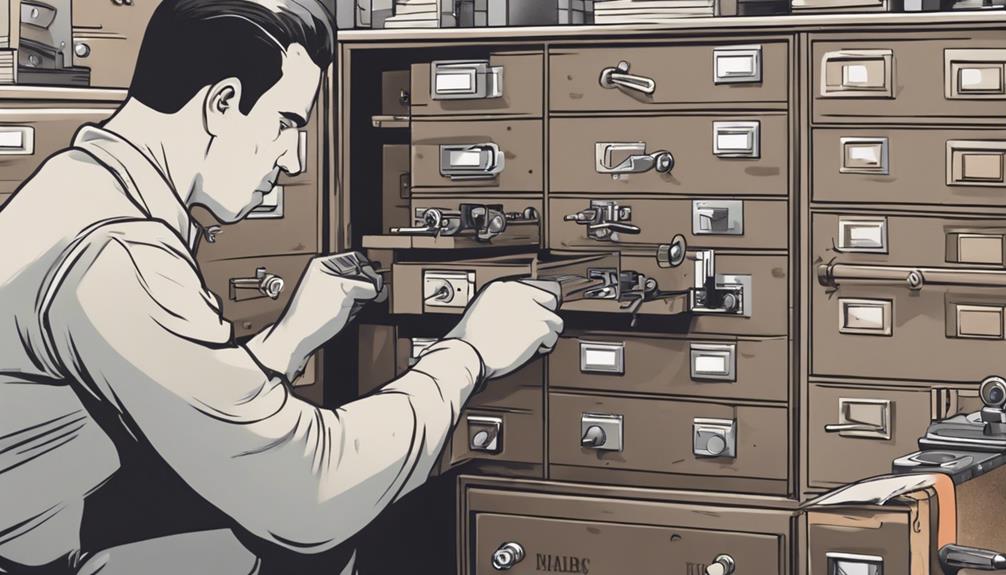
Seeking professional help from a low-rate locksmith can save you time and guarantee your file cabinet and desk locks are functioning at their best. Utilizing locksmith services guarantees that you avoid costly mistakes. Here's how a locksmith can assist you:
- Assessment: They evaluate the lock's condition to determine if it needs repair or replacement. If you're unsure about the lock's status, a locksmith can provide expert advice on whether rekeying (Understanding the Rekeying Process) might be a viable solution.
- Lock Repair: Experts perform precise repairs on damaged locks, restoring functionality.
- Key Duplication: They can create duplicates for easy access without compromising security.
- Maintenance Tips: Locksmiths provide advice on regular maintenance to prevent future issues.

